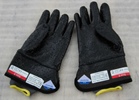
Safe Work at High Pressure
Specialty gloves designed to withstand the hazards of high-pressure jetting strikes must be used to prevent injury, and they can be used in other industrial applications where the operator is exposed to high-pressure fluids.
Benjamin Franklin was probably thinking about worker safety when he came up with "an ounce of prevention is worth a pound of cure."
We tend to take things for granted until they break down. One of the most common preventable injuries in the workplace affects the worker's hands. Worker concentration and focus is important but can be breached at a moment's notice, and without proper safety measures and the appropriate PPE, the worker is looking at a long recovery period.
Hand injuries can affect the anatomic alignment of various bones, tendons, and ligaments, along with the physiologic function. With the right treatment and enough time to heal, it is possible to restore the function of the hand and minimize future disability. Amputations of the thumb, fingers, and hand depend on the severity of the accident, where the injury occurred, and the machinery used. Workplace injury trends show hand injuries are on the rise and are an area of growing concern.
These injuries can be prevented by providing a glove that is designed with comfort and the user in mind. If they are easy to use and comfortable, they are more likely to be viewed as an accessory for the workplace than something that is worn merely to be in compliance with the law.
Because each industrial application exposes the worker to a number of different elements, it is necessary to identify the right glove for the specific operation. The hazards associated with a specific operation determine the type of protective gloves a worker needs to use for maximum protection. When workers are handling packages in a warehouse and or moving equipment, leather or knitted gloves might be adequate. In situations where the worker is handling chemicals or high-pressure liquids, it is important to have full coverage of the hands and a flexible fabric that allows dexterity while handling the equipment and facing the potential impact of rotary and flat (fan) jets of 500 bar/7500 psi or single (pencil) jets of 200 bar/3000 psi. Gloves have been field tested and designed to work under these conditions, offering the worker maximum flexibility, comfort, and protection.
In the high-pressure jetting industry, water jets are used with a range of nozzles for various applications. High-pressure jetting is mostly used for surface preparation, drain and pipe cleaning, and hydro-excavation. Specialty gloves designed to withstand the hazards of high-pressure jetting strikes must be used to prevent injury, and they also can be used in other industrial applications where the operator is exposed to high-pressure fluids, including hydraulics and paint.
The damage caused by the jets at these speeds can result in painful wounds that result in long recovery periods and disability for the worker, along with increased risk insurance, worker's compensation costs, and fines from OSHA for non-compliance for the employer.
How Serious Injuries Can Happen
A recent workplace accident demonstrates the need for specialty gloves designed for industry-specific functions. These gloves could have prevented an injury that occurred when an operator was using a high-pressure water jetting unit to clean a drain at a hospital and he accidentally ran his hand over a pinhole leak in the high-pressure hose. While the machine was running at only about 3000 psi, the pressure was enough to break the skin and make a sizeable cut into the palm of his hand because he was wearing a thin pair of latex gloves, as there were no jet-proof gloves available at the time. The operator was taken to a hospital, treated immediately, and is still undergoing treatment for his injuries two years later.
A lost-time injury of this nature can cost the company productivity and profitability. Many safety programs are designed for large corporations, but independent contractors and small-business owners risk much more. They could lose the dexterity of their hands even after a long healing process and suffer severe financial losses.
A new line of protective gear, including gloves, coveralls, aprons, jackets, and pants, can withstand high levels of pressure. The high-pressure safety gloves provide protection and flexibility to enable the worker to complete the task without constraints on his natural dexterity. They're comfortable yet offer high levels of protection against water jetting hazards, and therefore they are more likely to be used. They are designed for the toughest conditions, repelling dirt and water on the outside without compromising operator mobility. Protective clothing for these tasks meets the requirements for international safety standards and also meets OSHA standards.
It's important to ensure the gloves worn by workers for these applications are checked before each use, in order to confirm the integrity of the gloves and their ability to protect hands from any injury. They are the best defense against unnecessary and expensive workplace injuries.
Employers who provide the best personal protective equipment for their employees not only offer a safe working environment, but also can reduce their insurance costs and increase productivity. In the cost-benefit analysis of the investment in safety equipment, the cost of worker safety ensures the benefit of worker confidence, loyalty, and productivity.
This article originally appeared in the August 2013 issue of Occupational Health & Safety.